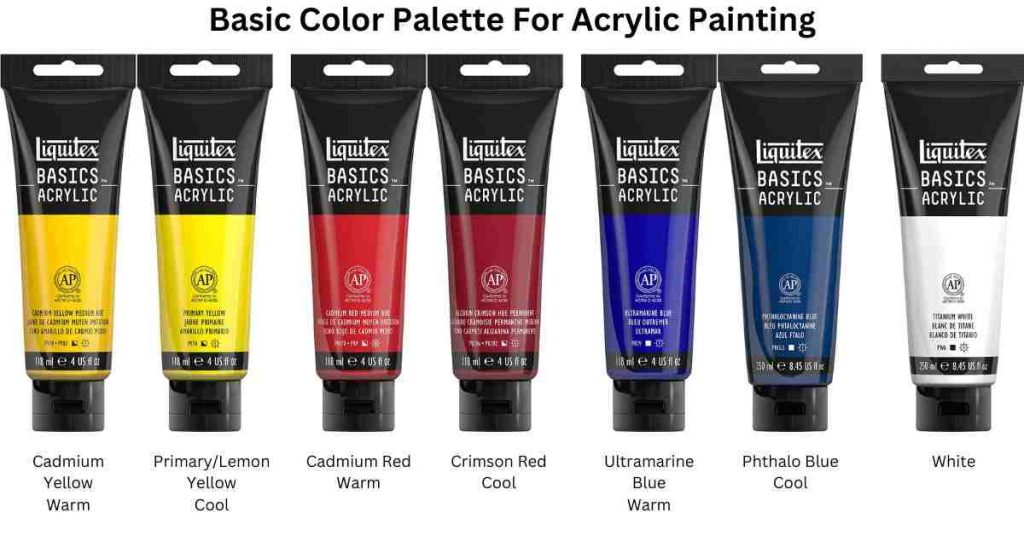Last Updated on March 27, 2024 by Masha Eretnova
Acrylic paint. Whether you’re a budding painter discovering the beauty of painting, or an expert who has used different methods to express your creativity with various media, it’s always a good thing to be familiar with the tools you’re using in your painting arsenal.
So the question is: “What is acrylic paint?”
Acrylic paint is made by suspending a paint pigment in an acrylic polymer solution. It has 3 ingredients: the pigment, the binder, and the vehicle. These ingredients react in a series of chemical reactions that become water-resistant when the paint dries, producing acrylic paint.
If you’re starting out, understanding how acrylic paint is made can help you determine how to use acrylics in your creative pursuits safely, and how to best use the properties of acrylic paint for your artistic endeavors.
Read on to learn more comprehensive information about acrylic paint and what people, from beginners to experts, ask about acrylics.

Table of Contents
The 4 Ingredients of Acrylic Paint

Creating acrylic paint requires 3 basic ingredients: the pigment, the binder (acrylic polymer), and the vehicle (water).
Acrylic paint is formed by suspending paint pigments in an acrylic polymer solution.
Acrylic polymers are formed from acrylate monomers. These monomers are similar in structure to molecules that make up many plastics.
Water makes acrylic paint water-based and polymer binder makes acrylic shiny and water-resistant when dry.
Sometimes acrylics have 4th ingredient – additives like preservatives, extenders, opacifiers, etc.
How these ingredients interact with one another is within the realm of Chemistry, and to help you visualize how acrylic paint functions (and forms) on a molecular scale, imagine the following:
- You hold a colored block encased in an air-tight, transparent, plastic wrapper.
- Now, imagine the block is put in water and suspended within it.
- As you see the suspended colored wrapper, scale it down to a minuscule size.
- Add more wrappers having the same size and color as the shrunk ones in the water.
Can you visualize the end result? That’s how acrylic paint works.
Your colored block is the pigment, the wrappers are your binders, and the water is the vehicle. With that simplification out of the way, you might be interested to learn if there are different types of acrylic paint.
Normally, acrylic paint has shiny glossy finish when dry contrary to other water-based paints, but some craft paints can dry to matter and you can also use matte mediums to alter the finish sheerness.
You can easily make your own acrylic paint with my tutorial!
The 2 Main Types of Acrylic Paint
There is no standard categories for the types of acrylic paint.
But in terms of how they are made, there are two, big categories or grades that can help you group up different acrylic paint products.
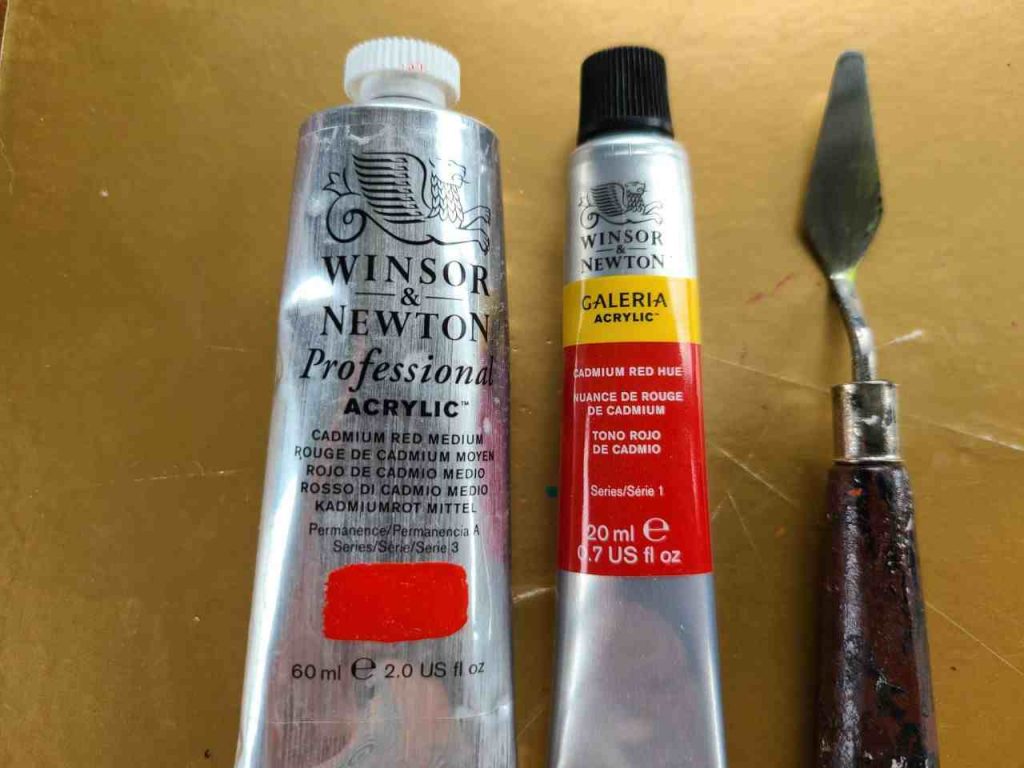
Professional artist David Glover, in his book, outlined 2 types of acrylic paint based on their manufacturing grades:
- Student acrylics have lower concentrations of pigments and use less expensive formulas. Because of this, they come in fewer available colors.
- Artist acrylics or Professional acrylics have higher pigment concentrations and use ingredients that make them more resistant to chemical reactions when exposed to water, sunlight, and open air.
Because the grades vary depending on manufacturers’ formulation, acrylic paint products can come in different varieties.
The 11 Varieties of Acrylic Paint
Acrylic paint is used on different surfaces and techniques and vary on a case-by-case basis. Manufacturers have created a variety of acrylic paint to meet these specific uses.
Here are some varieties of acrylic paint:
- Heavy Body Acrylics – this refers to how viscous or thick the paint is. This variety is used for impasto and heavier paint applications. Some brands which sell heavy body acrylics include Liquitex, and Golden.
- Medium Viscosity Acrylics – are more fluid than heavy body acrylics but contain similar concentrations of pigments. This type of acrylic paint has other names like fluid acrylics, high flow acrylics, and soft body acrylics. These paints are used when a smooth coverage is wanted. ARTEZA, Liquitex Soft Body, and Golden sell this type of acrylic.
- Open Acrylics – this is a special type of acrylic paint manufactured by Golden. It aims to address the quick time it takes for acrylic paints to dry. Specifically, this type of acrylic paint can dry anywhere between hours or days, depending on your application.
- Iridescent Acrylic Colors – a type of acrylic combined with mica powder or powdered bronze for a unique effect. This acrylic paint type is reflective and its iridescence depends on how coarse or fine the powder is mixed in with the pigment.
- Acrylic Gouache – like its name, it tries to go for a traditional gouache aesthetic but is water-resistant once the paint dries. This type of acrylic paint is commonly found by watercolorists, illustrators, and cartoonists. Turner Color, Liquitex, and Holbein are some brands that sell this type.
- Craft Acrylics – this type of acrylic paint can be used on wood, metal, and ceramic surfaces. This type of acrylic paint is used in decorative painting. The pigments aren’t often specified and are premade to achieve a wide range of colors. Apple Barrel is one the best brands that sell this paint.
- Interactive Acrylics – the “interactive” part of its name comes from its function where the paint is fast-drying but the artists can delay its drying or re-wet their work to do some wet blending. Chroma’s Atelier line has interactive acrylic paint options.
Read more: Best Acrylic Paint: 20+ Brands Reviewed for Beginners [From Cheap to Pro]
- Exterior Acrylics – this type of acrylic paint is made to last outdoors. Similar to craft acrylics, they can be applied to various surfaces including metal and concrete. These can be used for murals and outdoor signs.
- Acrylic Glass Paint – it is suited for glass surfaces as a temporary application, making it ideal for artists with a passion for decorative painting on glassware.
- Acrylic Enamel Paint – this acrylic paint is characterized by its smooth, hard shell once it dries. This type of acrylic paint can be baked in the oven.
- Acrylic Pouring Paint are specifically thinned with medium for acrylic pouring and they are ready to be used. You can save money on pouring medium. I’ve tried Hippie Crafter pour paint set and Mont Marte pouring paint set.
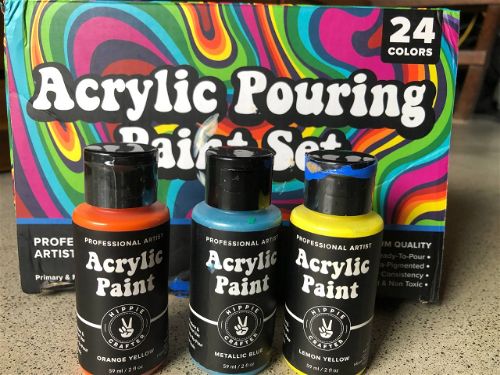
What is Acrylic Paint usually used for?
All paints are used to coat surfaces. Acrylic paint is a versatile and inexpensive type of paint, hence, its popularity among users.
Acrylic paint is used by manufacturers in different industries. Things like cars, household items, and even things you bring on your travels.
People also use acrylic paint for home improvement. And you, dear reader, use the paint in your hobbies and in honing your painting skills.
Other surfaces you can paint with acrylics include:
- Concrete
- Marble
- Granite
- Stone
- Asphalt
- Tile
- Fabric
- Leather
- Shoes
- Plastics
- Metal
- Wood
- Canvas (for painting, abstract art, pouring)
- Paper (including all varieties of paper)
- Glass and windows
- And many more
Essentially, using the paint is a matter of what surfaces you’ll apply it on, the techniques and tools you have, and most especially–your budget in purchasing acrylics.
Related: Can You Mix Oil And Acrylic Paint? How To Best Use Oils And Acrylics Together
Is Acrylic Paint thick or fluid?
How viscous acrylic paint is dependent on the concentrations between the 3 main ingredients of acrylic paint.
The viscosity varies between brands and even product lines from the same brand.
You can have thick acrylic paint like those heavy body acrylics or fluid options like your high-flow acrylics.
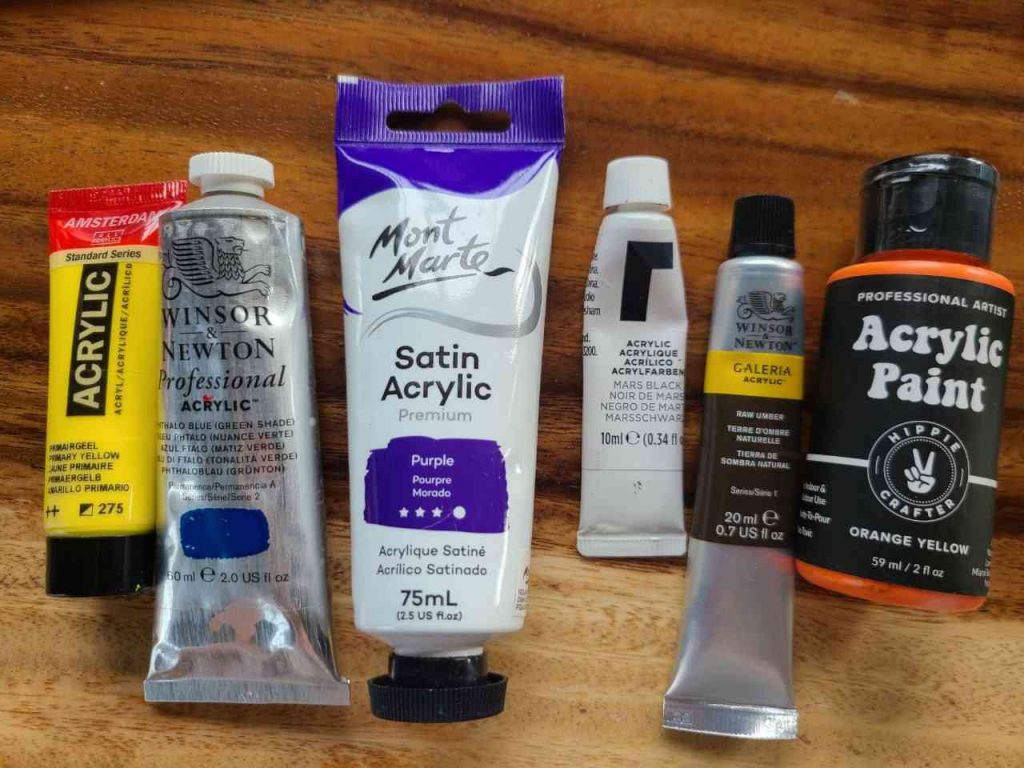
Moreover, you can add thinners (like one from Tamiya) and gel solutions (like this one from Liquitex) to adjust the thickness of your acrylic paint.
Adjusting how thick your paint is, influences how long it takes for the paint to dry.
If you need to make your paint thinner or thicker, try one of these methods:
- 14 Ways How to Make Acrylic Paint Thicker: A Comprehensive Guide
- How to Thin Acrylic Paint: 3 Correct Ways & 3 Dont’s
Is Acrylic Paint toxic?
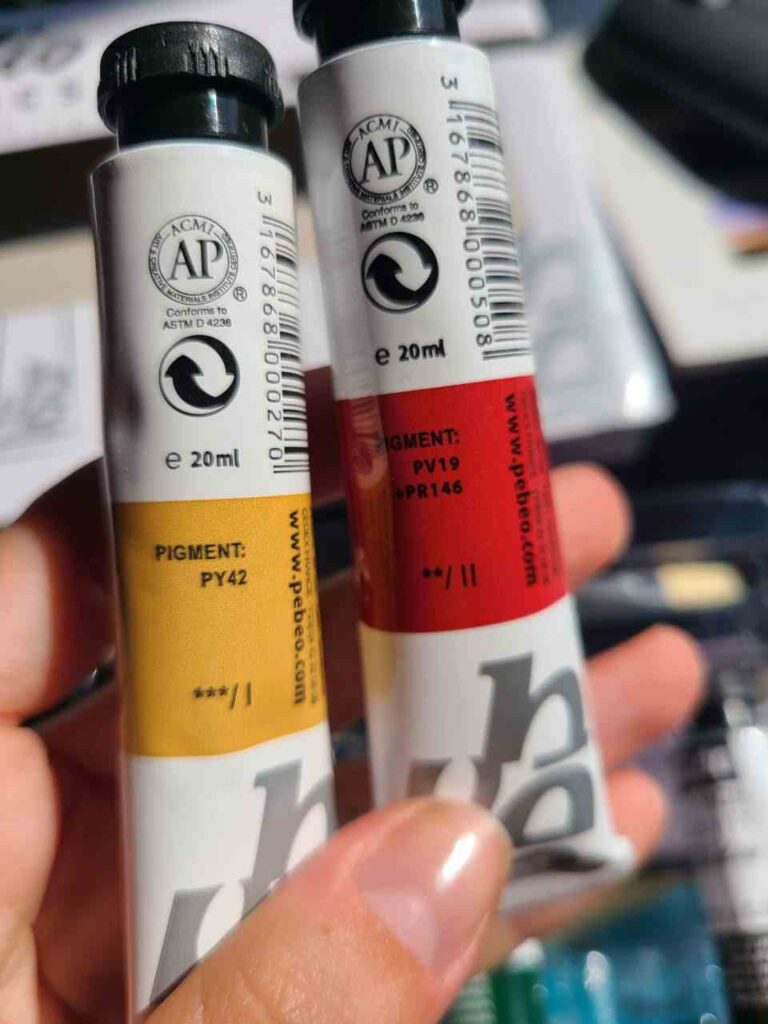
Acrylic paint is made up of chemicals that are foreign to the human body.
However, it takes large amounts of those chemicals to enter your body before you show symptoms of poisoning. So yes, acrylic paint is toxic.
Moreover, it also depends on how sensitive your body reacts to having contact with acrylic paint.
Acrylic paint allergy occurs in the population, but it’s an extremely small percentage of society.
If you have a history of skin-related diseases and allergies, then you might be more sensitive to acrylic paint than other people.
Read more: Can You Put Acrylic Paint On Your Face & Body?
Inhaling paint fumes is the most common mode that acrylic paint becomes toxic to people.
Some of these potentially toxic paint colors include Cadmium red, Cadmium yellow, Cadmium orange, Cerulean blue, Cobalt blue, and
If your acrylic paint is manufactured in the US, look for the ASTM D4236 label which verifies it was tested and is relatively non-toxic.
Acrylics made outside the US might have a different convention for assessing the toxicity of the paint.
Here’s a trivia. Paint’s toxicity comes from volatile organic compounds or VOCs which come from the ingredients used to make the paint, and are harmful when they enter the body in large amounts.
Contrary to oils and turpentine, acrylic paint doesn’t have a very strong odor. But some brands and colors will still smell.
Especially if you are having a long painting session, sensitive to odor, or painting your whole room with latex acrylic, consider how you will get rid of the paint smell beforehand.
Is Acrylic Paint eco-friendly?
If you’re just using acrylic paint as a hobby, you wouldn’t be harming the planet compared to a factory that uses acrylics on a larger, manufacturing scale.
But because acrylic paint is synthetically-made, they’re a bit less eco-friendly than natural pigments.
Remember that acrylic paint at its core uses plastic polymers.
Even if the science is still out on how harmful run-off containing paint is to the environment, being mindful of how you use acrylics would already be a big help to the planet.
There are more eco-friendly alternatives to acrylic paint thankfully.
If you think how you’re using the paint harms the environment, you can opt to use natural inks and pigments when painting.
Is Acrylic Paint permanent or washable?
In general, you can wash off acrylic paint using warm water and soap. When the acrylic paint is still wet, it’s easier to wash it with water alone.
Acrylic paint becomes harder to wash off with water once the paint dries. In most instances, it’s difficult to wash off dry acrylic paint on many surfaces.
Additionally, depending on the formulation of your acrylic paint, you may need to use more water and soap, or add stronger detergents to wash off the paint.
You might want to note the drying time of your acrylic paint to avoid wasting water and soap. The drying time often varies on how thick your application of the paint is and differs by brand.
For example, Winsor & Newton’s acrylics dry between 10 to 20 minutes for thin films and up to an hour or more for thicker ones. Their professional acrylics dry after 30 minutes for thin application.
Washing off acrylics also depends on the surface you’re working on.
For instance, when washing off acrylic paint from a canvas, you may need to soak it in warm water with soap for a long time. For glass, you can wash the surface using soapy water and it’ll remove your paint easily.
Here’s an extensive look at how washable acrylic paint is and how to remove them on different kinds of surfaces–from cloth to metal.
Is Acrylic Paint waterproof?
Dried acrylic paint is water-resistant but it isn’t completely waterproof.
However, you can water-proof it by using the appropriate product.
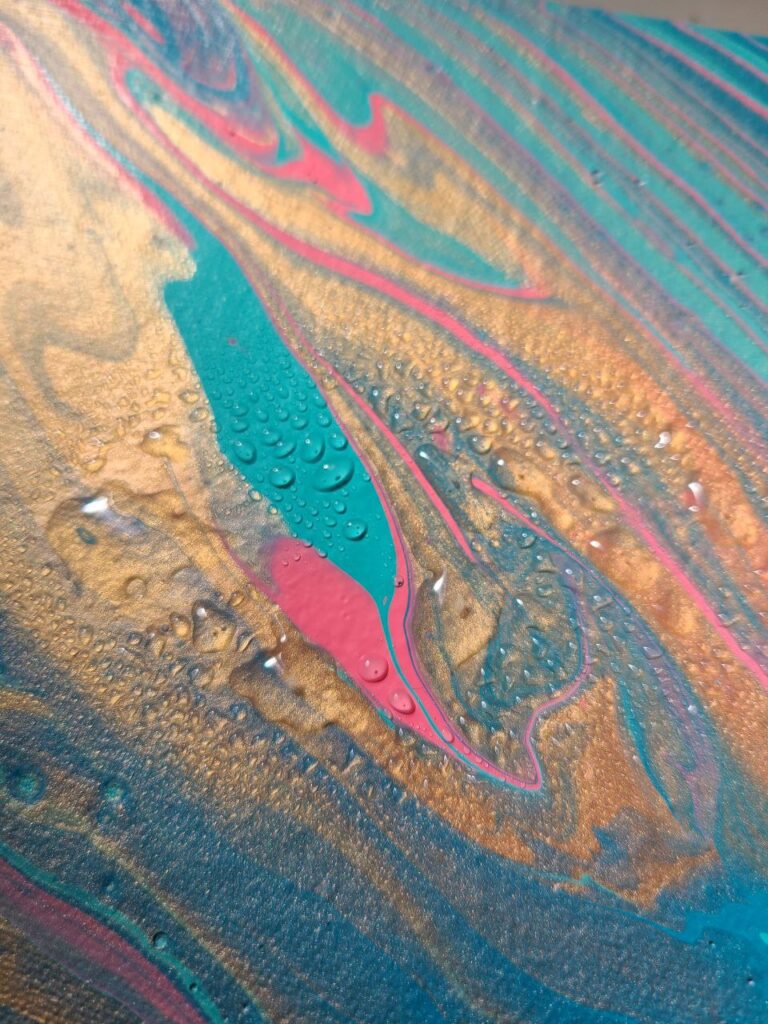
Read more: Is Acrylic Paint Waterproof? 11 Ways to Make Acrylics Waterproof
Water-proofing your acrylic paint is based on the surface you’re painting on.
Acrylic paint on a canvas can be waterproofed by varnishing or applying epoxy to it.
Liquitex sells basic and professional tiers of glossy varnish that can be used to waterproof on canvas.
Waterproofing acrylic paint on fabric needs a fabric medium to be added to the paint. Here’s one from Liquitex. For other surfaces, you have to prime and seal the paint.
These surfaces range from glass to concrete.
Fun fact: Baking ceramics and clay will waterproof the acrylic paint you’ve used on them.
Is Acrylic Paint flammable?
In general, all kinds of paint are flammable or combustible.
However, their flammability depends on what ingredients were used to make them and if they’re wet or dry.
Acrylic paint isn’t flammable when it’s wet but is prone to combustion when it’s dry.
Flammable acrylic paint comes with ingredients that burn at room temperature. One such ingredient is ethanol (ethyl alcohol). Combustible paints are those that require higher temperatures to ignite.
Dried acrylic paints are combustible at 560°F (293.33°C) and it isn’t a good idea to burn dry paint as it releases noxious fumes.
Is Acrylic Paint opaque or transparent?
Acrylic paint is rarely completely opaque or completely transparent and lies somewhere in between being on a more opaque side.
Opacity depends on a specific color you use and technique.
There are techniques to make your acrylic paint more opaque or more transparent and there are different reasons why painters would want to make their paint appear on different ends of the opacity and transparency spectra.
The most obvious reason is “coverage,” which is how much paint can mask a given surface.
Imagine painting on a black background, the more transparent your acrylic paint is, the more your dark background pops out.
In addition, adding a transparent layer of paint adds a sense of dimension to your work, which captivates people.
These are just some reasons but it heavily depends on the artist and how they want their paint to influence their artwork.
Is Acrylic Paint better than other paints?
There are advantages and disadvantages when using acrylic paint. It, being “better” than other types of paint, will depend on your usage.
For illustrations, sketches and small art gouache is perfect, for more transparency – watercolor, for more old school landscapes or portraits both acrylics and oils will perform great.
Additionally, each kind of paint has different considerations for use and will depend on the vision of skills of the artist and the use of water. Ex., acrylics need way less water than watercolor, but you need some skills to blend it.
Apart from acrylic paint, here are some alternative media you can use for your artwork:
- Oil Paint
- Watercolor
- Gouache
- Latex Paint
- Poster Paint
- Tempera
Each one will have its advantages over acrylic paint so read our comparisons.
For example, oil paint takes longer to dry compared to acrylic paint. Painters working on longer projects tend to prefer these types of paint over regular acrylics.
Where can you use Acrylic Paint?
You can use acrylic paint to coat different kinds of surfaces. With each surface type, there are different considerations. Here are surfaces where you might want to paint with guides on using acrylics on them:
Some people use acrylic paint on the skin but this isn’t advisable.
You don’t know how a person will react to the ingredients used in the paint. Instead, use face and body paint, like this one from UCANBE.
Read more: How To Remove Acrylic Paint Easily? Full Guide (Skin, Fabric, Floor, Wood, etc)
These are just some places where you can use acrylics but you can think outside the box by employing different techniques on these surfaces. Have you heard of the pouring technique?
You can mix and combine techniques with various surfaces to show your artistry. An example would be pouring on a cabochon base (like this one) will allow you to make jewelry from acrylic skin.
Does Acrylic Paint need priming and varnish?
Priming and varnishing are often used to protect against wear from the elements (like waterproofing in previous sections), but it isn’t a necessity for the average user.
In most instances, you won’t need to prime and varnish your acrylic paint.

But you have the option to prime and varnish acrylics to add an extra layer of protection to your work.
- Gesso paint is one product used to prime the surface before acrylic paint. It’s like white paint but thinner and has some plaster-like ingredients. Applying gesso on any surface makes it easier for your acrylic paint to adhere and be smooth.
- A varnish is applied after painting to add a layer of protection to your work. Golden sells varnishing for acrylics. Some professionals put an isolation coat first and only then vasrnish their artworks.
If you plan to protect your acrylic painting, there are general steps you can take to protect your outputs. You can store them at room temperature once the paint dries, keep your painting away from heat, or don’t expose your work to the outside elements.
The good thing is that acrylic paintings can last just as long as oil painting if takengood care of. Even unopened acrylic paint jars (professional) can stay good up to 15 years.
Learn more about acrylics shelf lives: How Long Does Acrylic Paint Last? 24 Brands Explained
What supplies do you need to work with Acrylics?
There are 3 basic things you need to work with acrylics:

- Your acrylic paints,
- Your brushes, and,
- A surface to work on (start with paper or canvasses).
You can argue that there are only 2 if you don’t use a brush and you will also sooner discover that tools you can adapt to use with paint are endless. I would argue that you absolutely need a palette to start learning color mixing and store your paint during painting.
There are other tools, but these three will suffice if you’re just starting out as a painter.
At the same time for me easel is absolutely optional and I work sitting and use short-handled brushes, but if you prefer standing, you can buy an easel, but be prepared that a good one will be not cheap.
How many acrylic paint color do I need?
Based on color theory we have only 3 primary colors in painting: red, yellow and blue. They help us mix absolutely all other colors, even black. We additionally need white to change the value of the colors, to make them lighter.
So you need 4 colors to start you may think, and it is quite right, but. You probably heard about warm or cool light. The same applies to colors, we have warm (reddish colors) and cool (blueish colors). When they are mixed they give different results and even mud. We need to have warm and cool version of each primary color.
So you need 7 paint tubes in total to start with acrylic painting:
- warm red, ex. Cadmium Red
- cool red, like Crimson Red
- warm yellow, like Cadmium Yellow
- cool yellow, like Lemon Yellow
- warm blue, like Ultramarine blue
- cool blue, like Phthalo Blue or Prussian Blue
- white (Titanium white)
If you are not sure you can do it without black, add 8th tube of Mars or Ivory Black to your collection. I talk in details about color mixing theory in this guide: How To Mix Acrylic Paint? – Your Complete Color Mixing Guide.
This way you don’t have to settle for cheap paint and you will progress much faster as an artist. Yet there is nothing wrong with buying a bit paint set and enjoy beautiful colors in it!
How to use Acrylic Paint?
Get your brushes, canvas, and paint. On the canvas, visualize the output. Sketching on the canvas will help you get a look at the outline of the end result. Using graphite pencils can help you sketch the design of your work on canvas (check out Faber-Castell’s graphite pencils).
You might want to check out my collection of ideas if you feel stuck. I got a few tutorial from flowers and puppy to a full list of ideas for Star Wars day and other holidays!
Painting on a canvas can be summarized into 3 main parts:
- preparation,
- painting, and
- protection. Of the three, prepping and protecting your work goes a long way toward prolonging your outputs.
You might be rearing to work with acrylic paint already. But always remember that your acrylic paint and art supplies are tools to express your creativity. I also got 50 acrylic painting tips that may help you upgrade your skill a little bit.
Remember: It is important to know how to use the tools but it’s more important to understand the underlying concepts to make a visually-alluring work of art.
Keep on learning color theory, visual design techniques, and painting concepts to nurture the artist in you.
I am serious about color theory – How To Mix Acrylic Paint? – Your Complete Color Mixing Guide
Common Acrylic Painting mistakes. Is Acrylic Paint forgiving?
Acrylic paint is forgiving for beginner painters. It is less forgiving than gouache though. While acrylic paint is wet, it’s possible to wash off the paint. The difficulty increases when your paint dries.
Depending on where you are in the painting process, you can commit several mistakes. Here are some common ones:
Over-diluting your paint with water. Adding too much water can cause your paint to be too watery, and to flake off as too much water will stop your acrylic polymer from holding the pigment properly. In short, water can affect how strong your acrylic paint latches on a surface.
- The fix: Use a polymer medium like this one from Sargent Art. A polymer medium dilutes your acrylic paint without affecting the pigments.
Waiting too long to blend. This will vary on how much paint you’ve applied. Dried acrylic paint is hard to blend so you might end up with lumps or even tear your canvas.
- The fix: Use an acrylic glaze (this one’s from Liquitex) or medium. They help prolong the time it takes for your acrylics to dry.
Not mixing your colors properly. Combining primary colors to make secondary ones is an exciting thing to do. However, what if there’s a particular hue of violet you want or a specific shade of green? Do you know how many whites and blacks to add?
- The fix: Learn about color theory. A basic understanding of how colors will react with each other will also help you grow as an artist.
Using the same brush. Apart from the possibility of mixing different colors (contaminating one another, so to speak), different strokes and brush sizes will also allow you to hone your technique as an artist.
- The fix: Buy a brush set and place them near your canvas and palette when painting.
Paint dried and cracked. A few reasons why – if it is pouring, the paint was too thin and maybe too much water, if regular painting it can also be that you didn’t allow the paint to dry properly, used too thick layers and many other reasons.
- The fix: learn about thinning acrylic paint and drying times. If the cracksdo not look artistic, scrape the painting or try to fill the cracks in with paint. Check also: How To Fix Cracked Acrylic Painting in 3 Easy Ways.
- If the paint dried and cracked on palette you can try to rehydrate it but if it was sitting there too long, you just need to discard it.
Acrylic Paint FAQs
We talked about acrylic paint extensively, but we might not have covered everything. Here are some questions asked by beginners and even experienced artists.
What is the weakness of Acrylic Paint?
Acrylic paint has various strengths and weaknesses. Its main weakness is its quick dry times. Acrylic paint has other weaknesses that often relate back to its drying time.
Some acrylic paint contains toxic ingredients in the pigment. This is evident for acrylics which use “retarders” to slow down their drying time.
Once the acrylic dries, it’s difficult to remove, alter, and blend. So you need to work quickly when painting with acrylics.
In terms of commercial value, acrylic paint isn’t viewed as high value, unlike other paint media, by many art galleries and most collectors.
What are the strengths of Acrylic Paint?
Acrylic paint has a lot of strengths as a medium. Its drying time might be quick, but that makes it a popular choice for people who want to see results immediately.
Moreover, because acrylic paint is water-based, you don’t need paint thinners and turpentine (which are toxic substances) to clean your tools as soap and water are enough.
Acrylics are also able to coat a lot of surfaces, there are a few exceptions though as you’ll see in the next question.
What will Acrylic Paint not stick to?
Acrylic paint sticks to various surfaces. Painting on smoother surfaces mechanically makes it harder for the paint to stick to. That’s why you might find yourself using more paint on smooth plastic than on a textured one.
However, the more likely factor is how the binder in your paint latches on the surface you’re working on. This is plainly chemistry in the works.
A simplification of this is that your binder is weakened when painted on surfaces made from similar ingredients as the binder. Imagine the binder dissolves on the surface, so it wouldn’t let your paint stick properly.
Some of these materials include Teflon, nylon, and silicones. These materials are made from diesel products, similar to acrylics. In addition, surfaces with wax and oil will prevent acrylics from sticking properly.
How long does Acrylic Paint take to dry?
Acrylic paint dries depending on the amount you’ve applied and the ingredients used by the brand. Here’s a look at the drying times of 30 different acrylic paint brands.
In general, acrylics dry between 10 to 30 minutes and hours if you use a lot of paint. You can prolong their drying time by adding acrylic glazes and acrylic media.
Can I use Acrylic Paint on my pets?
Normally, you wouldn’t want to paint on your pets as they might also react negatively to paint as people do.
Your furry friend might be able to tolerate the paint on their coat but you can’t use it on other animals like birds, reptiles, amphibians, and fish.
The more aquatic your pet is, the riskier it’ll be when it is exposed to acrylics. Birds, on the other hand, might feel an increase in weight if the paint dries on their feathers.
Can I use Acrylic Paint on plants?
Plants are less likely to be affected than animals when you paint on them. However, that depends on where you’ll paint them.
If you paint on the underside of leaves, you’re clogging them from doing photosynthesis properly. If a lot of paint dries up on the soil where your plant is on, it might clog the roots and prevent water from seeping directly into the soil.
Wrap-Up
Acrylic paint is an extremely versatile kind of paint.
Owing to the way it’s created, it can be applied to a plethora of surfaces, making it a popular choice for people to express their creativity in a short amount of time.
Its fast drying time serves both as a blessing and a bane to different artists, so familiarizing yourself with acrylic paint will give you an edge and drive you far in your painting pursuits.
Though it has some disadvantages, it isn’t enough to dissuade people and is offset by its diverse strengths for painting.
Whether you’re a beginner or an advanced artist, there’s no harm in having acrylic paint in your arsenal, right?

Masha Eretnova, born in 1991, is a Buenos Aires-based certified teacher, artist, and member of the Professional Artist Association with 20+ years of personal painting journey.
She started painting and drawing very early and is now an international abstract artist and educator passionate about acrylic painting, gouache, and crafts.
Her works are part of international exhibitions and contests, including ArtlyMix (Brazil), Al-Tiba 9 (Spain), Exhibizone (Canada), Italy, and many more.
Besides her artistic pursuits, Masha holds a post-grad diploma in Teaching Film Photography and 2 music school diplomas: piano and opera singing.
